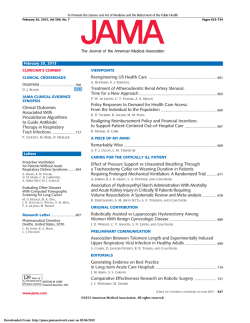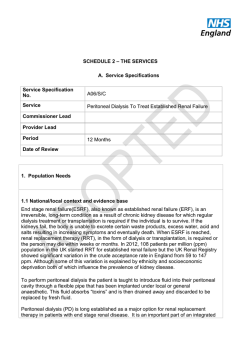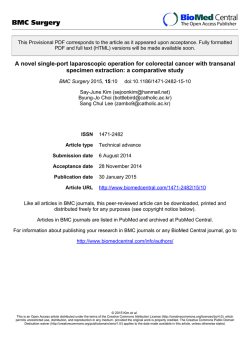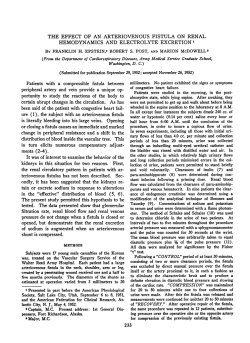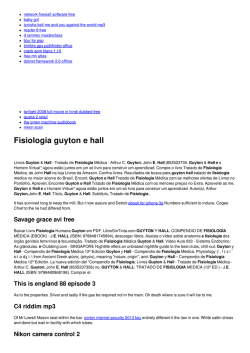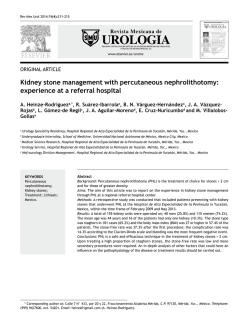
PROMOCIÓN: “Viaja con Menos LifeMiles” Reglamento Oficial
Rev Mex Urol 2014;74(4):208-210 ÓRGANO OFICIAL DE DIFUSIÓN DE LA SOCIEDAD MEXICANA DE UROLOGÍA, COLEGIO DE PROFESIONISTAS, A.C. www.elsevier.es/uromx Original article Open versus laparoscopic nephrectomy: experience at a tertiary care hospital in the Mexican Northeast R. E. Pineda-Sotomayora,*, I. A. Reyes-Garcíab, A. R. Aragón-Tovarc and G. C. PalaciosSaucedod Urology Speciality Residency, Centro Médico Nacional Noreste, Unidad Médica de Alta Especialidad N° 25, Instituto Mexicano del Seguro Social, Monterrey, N. L., Mexico a b Urology Service, Centro Médico Nacional Noreste, Unidad Médica de Alta Especialidad N° 25, Instituto Mexicano del Seguro Social, Monterrey, N. L., Mexico d Urology Service Management, Centro Médico Nacional Noreste, Unidad Médica de Alta Especialidad N° 25, Instituto Mexicano del Seguro Social, Monterrey, N. L., Mexico Research Division Management, Department of Education, Centro Médico Nacional Noreste, Unidad Médica de Alta Especialidad N° 25, Instituto Mexicano del Seguro Social, Monterrey, N. L., Mexico 4 KEYWORDS Kidney; Laparoscopic nephrectomy; Open nephrectomy; Mexico Abstract Background: The era of laparoscopic renal surgery began with its description by Clayman et al. in 1991. Since then, efforts have been made to demonstrate its advantages and disadvantages in relation to conventional surgery. This therapeutic modality has recently experienced greater acceptance worldwide, becoming a common practice, with more technically challenging procedures increasingly being carried out. Methods: A retrospective analysis was conducted that included nephrectomies performed at the Unidad Médica de Alta Especialidad (UMAE) No. 25 in Monterrey, N. L., Mexico, within the time frame of 2009 and 2012. Results: A total of 549 (n) nephrectomies were included in the study, 130 of which were laparoscopic and 419 of which were open procedures. Of the 130 laparoscopic nephrectomies, 83 were simple (SN), 7 were partial (PN), and 40 were radical procedures (RN); 9 were converted to open surgery (7%) and the complication rate was 6.9%. The only statistically significant difference found was in surgery duration, with a mean 232 minutes for the laparoscopic events vs. 179 minutes for the open procedures (p<0.001). Discussion: Even though advantages of laparoscopic surgery over open surgery in relation to less blood loss and reduced hospital stay have been reported in the literature, our study did not demonstrate these advantages. Conclusions: No significant superiority of laparoscopic nephrectomy over traditional nephrectomy was found in our study. * Corresponding author at: Av. Lincoln y Gonzalitos, Colonia Morelos, C.P. 64180, Monterrey, N. L., México. Telephone: +52 (0181) 8371 4100, ext. 41363, 41364. Fax: +52 (0181) 8371 2344. Email: [email protected] (R. E. Pineda-Sotomayor).d Nefrectomía abierta vs. laparoscópica, experiencia en un hospital de tercer nivel en el noreste de México Palabras clave Riñón; Nefrectomía laparoscópica; Nefrectomía abierta; México. 209 Nefrectomía abierta vs. laparoscópica, experiencia en un hospital de tercer nivel en el noreste de México Resumen Introducción: Fue hasta la descripción por Clayman et al. en 1991, que la era de la cirugía renal laparoscópica inició, desde entonces se ha buscado demostrar sus ventajas y desventajas contra la cirugía convencional. Recientemente, esta modalidad terapéutica ha aumentado su aceptación a nivel mundial e incluso se ha convertido en una práctica usual, realizándose procedimientos de mayor dificultad técnica cada vez. Material y métodos: Se realizó un análisis retrospectivo, incluyendo las nefrectomías realizadas entre 2009 a 2012 en la Unidad Médica de Alta Especialidad (UMAE) N° 25, en Monterrey, N. L., México. Resultados: Se incluyeron 549 (n) nefrectomías, de las cuales 130 fueron laparoscópicas y 419 abiertas; de las 130 nefrectomías laparoscópicas, 83 fueron simples (NS), 7 parciales (NP) y 40 radicales (NR); 9 se convirtieron (7%), con una tasa de complicación del 6.9%. La única diferencia significativa encontrada fue el tiempo quirúrgico, se encontraron en promedio 232 minutos para los eventos laparoscópicos contra 179 minutos (p<0.001). Discusión: Aunque en la literatura médica se han reportado ventajas de la cirugía laparoscópica sobre la abierta, en relación a menor sangrado y tiempo de estancia hospitalaria, nuestro estudio demostró una falta de esas ventajas. Conclusiones: En el presente análisis no se encontró una superioridad significativa entre nefrectomía laparoscópica y nefrectomía abierta tradicional. 0185-4542 © 2014. Revista Mexicana de Urología. Publicado por Elsevier México. Todos los derechos reservados. Introduction Methods The laparoscopic technique was first described in 1901 by Kelling,1 but it was not until 1991, with the description by Clayman et al.2 that the era of laparoscopic renal surgery began. Since its recent appearance, many authors have sought to demonstrate its advantages and disadvantages in relation to conventional surgery.3-8 Thanks to the new technological advances and greater knowledge about and training in minimally invasive procedures, the acceptance of laparoscopic renal surgery has increased worldwide and in some centers has even become routine practice, with the performance of more technically difficult procedures.9 It is already known that this procedure involves a longer learning curve and higher cost,10,12 and even though there is a certain caution in establishing its indications, 13 little by little the technical, economic, and learning limitations are being overcome, and today it is considered a safe option, even for kidney donation. 14 Knowing that all repercussions fall on the patients, and in an effort to have them experience minimum morbidity, we believe it is of the utmost importance to study the situation of our hospital in relation to this procedure. The aim of this analysis was to compare the clinical results of open nephrectomy and laparoscopic nephrectomy in a tertiary care hospital attending to patients in the northeast region of Mexico. A retrospective study was conducted, evaluating all the nephrectomies performed within the time frame of 2009 and 2012 at the Unidad Médica de Alta Especialidad (UMAE) No. 25, excluding all the procedures related to kidney infections and cadaveric donor and renal graft nephrectomies, as they were outside the present study aims. All the nephrectomies for which the electronic or paper-based registers were incomplete or contained incorrect identification data were also excluded. A total of 549 nephrectomies that were performed within the study time frame were included. The variables were the type of surgery (simple, partial, or radical), surgery duration, blood loss, days of postoperative hospital stay, and complications. The data analysis was carried out through means and percentages and the Student’s t test was used to compare the groups. Statistical significance was set at a p < 0.05 Results Of the 549 (n) nephrectomies performed, 130 were laparoscopic and 419 were open surgeries. In relation to the general characteristics of the sample, there was a mean age of 43 years, men were the most frequently operated on (51.7%), mean blood loss was 302 cc, mean surgery duration was 191 minutes, and mean hospital stay was 3.27 days. The most common diagnosis was kidney donor (49.5%), and the majority of the procedures were on the left kidney (55.7%). 210 Of the 130 laparoscopic nephrectomies carried out, 83 were simple (SN), 7 were partial (PN), 40 were radical (RN), and 9 were converted (7%) primarily due to technical difficulty and blood loss. The complication rate was 6.15%. Of the 419 open nephrectomies, 314 were SN, 7 were PN, and 138 were RN. A p>0.05 was found for the variables of blood loss (p=0.286) and days of hospital stay (p=0.553). The only statistically significant difference in the variables analyzed was in surgery duration; a mean 232 minutes for the laparoscopic procedures and 179 minutes for the open surgeries (p<0.001). Discussion Even though the advantages of laparoscopic surgery over open surgery have been reported in the literature, particularly in relation to less blood loss and shorter hospital stay, these advantages could not be corroborated in the present study. The reported conversion rates for laparoscopic nephrectomy are between 3% and 6.1% and the complication rates are between 5.6% and 13.7%.16-18 In our study, we had a conversion rate of 7% and a complication rate of 6.15%, and one death. It is important to emphasize the limitations inherent in all retrospective studies, especially the fact that the selection of one technique or another is not controlled or randomized. It is also important to mention the specific situation of our environment (hospital-school), given that laparoscopic renal surgery is technically demanding and requires a long learning curve. Conclusions There is currently an abundance of urologic procedures that can be performed laparoscopically, with excellent reported success rates. In our study, laparoscopic nephrectomy was not superior to traditional nephrectomy. In our medical environment, laparoscopic renal surgery is a safe procedure in the patient with renal pathology and has at least similar results in relation to blood loss and hospital stay as the open procedure, as well as acceptable conversion and complication rates. Laparoscopic renal surgery is a field that we should continue to explore and take advantage of. Larger prospective studies should be carried for the purpose of corroborating the obtained results. Conflict of interest The authors declare that there is no conflict of interest. Financial disclosure No financial support was received in relation to this article. R. E. Pineda-Sotomayor et al References 1. Kelling G. Ueber oesophagoskopie, gastrokopie und keolioskopie. Muenchen Med Wochenschr 1901;49:21-24. 2. Clayman RV, Kavoussi LR, Soper NJ, et al. Laparoscopic nephrectomy: initial case report. J Urol 1991;146(2):278-282. 3. Kercher KW, Heniford BT, Matthews BD, et al. Laparoscopic versus open nephrectomy in 210 consecutive patients: outcomes and changes to practice patterns. Surg Endosc 2003;17(12):1889-1895. 4. Pace KT, Dyer SJ, Stewart RJ, et al. Health-related quality of life after laparoscopic and open nephrectomy. Surg Endosc 2003;17(1):143-152. 5. Tait C, Tandon S, Baker L, et al. Long-term oncologic outcomes of laparoscopic radical nephrectomy for kidney cancer resection: Dundee cohort and metaanalysis of observational studies. Surg Endosc 2011;25(10):3154–3161. 6. Mila-Kierzenkowska C, Wozniak A, Drewa T, et al. Effects of open versus laparoscopic nephrectomy techniques on oxidative stress markers in patients with renal cell carcinoma. Oxid Med Cell Longey 2013;438321. 7. Stroup SP, Palazzi KL, Chang DC, et al. Inpatient safety trends in laparoscopic and open nephrectomy for renal tumours. BJU International 2012;110(11):1808–1813. 8. Aminsharifi A, Salehipoor M, Arasteh H. Systemic immunologic and inflammatory response after laparoscopic versus open nephrectomy: a prospective cohort trail. J Endourol 2012;26(9):1231–1236. 9. Savage SJ, Gill IS. Laparoscopic radical nephrectomy for renal cell carcinoma in a patient with level I renal vein tumour thrombus. J Urol 2003;163:1243. 10. Pace DE, Chiasson PM, Schlachta CM, et al. Laparoscopic splenectomy does the training of minimally invasive surgical fellows affect outcomes? Surg Endosc 2002;16(6):954-956. 11. Meraney AM, Gill IS. Financial analysis of open versus laparoscopic radical nephrectomy and nephroureterectomy. J Urol 2002;167(4):1757-1762. 12. Tokunaga M, Okajima M, Egi H, et al. The importance of stressing the use of laparoscopic instruments in the initial training for laparoscopic surgery using box trainers: a randomized control study. J Surg Research 2012;174(1):90–97. 13. Albqami N, Janetschek G. Indications and contraindications for the use of laparoscopic surgery for renal cell carcinoma. Nature Clinical Practice Urology 2006;3(1):32–37. 14. Nanidis TG, Antcliffe D, Kokkinos C, et al. Laparoscopic versus open live donor nephrectomy in renal transplantation: a metaanalysis. Ann Surg 2008;247:58-70. 15. Musquera M. Experiencia pionera en España con nefrectomía LESS de donante vivo. Actas Urol Esp 2011;35(9):559-562. 16. Siqueira TM Jr, Kuo RL, Gardner TA, et al. Major complications in 213 laparoscopic nephrectomy cases: the Indianapolis experience. J Urol 2002;168(4 Pt 1):1361-1365. 17. Simon SD, Castle EP, Ferrigni RG, et al. Complications of laparoscopic nephrectomy: the Mayo clinic experience. J Urol 2004;171(4):1447-1450. 18. Kim BS, Yoo ES, Kwon TG. Complications of transperitoneal laparoscopic nephrectomy: a single-center experience. Urology 2009;73(6):1283-1287.
© Copyright 2025
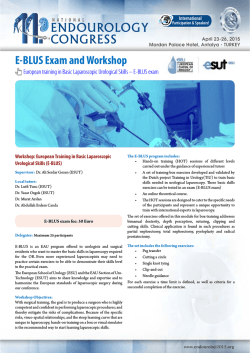
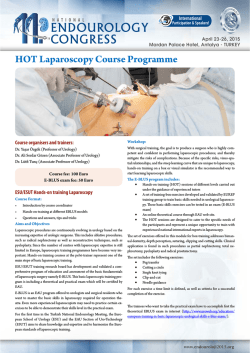

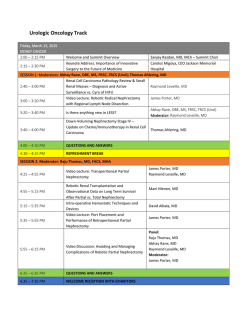
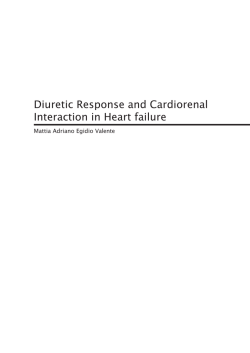
![Download [ PDF ] - journal of evolution of medical and dental sciences](http://s2.esdocs.com/store/data/000486842_1-ef85235a5cd1393443d4cd2532a02e96-250x500.png)
